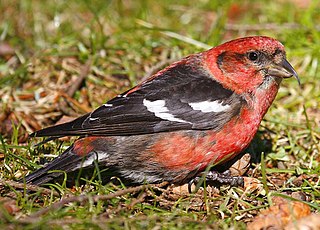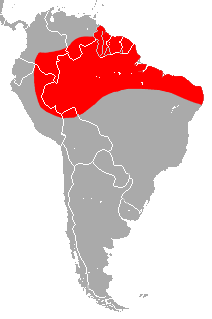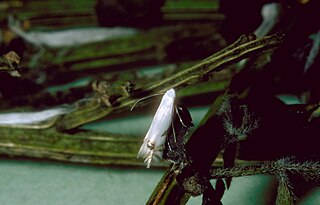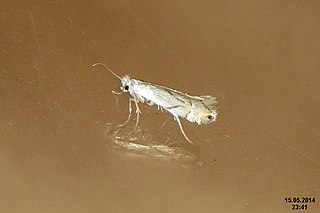
The two-barred crossbill or white-winged crossbill is a small passerine bird in the finch family Fringillidae.

The white-winged lark is a species of lark found from southern Ukraine through Kazakhstan to south-central Russia. It is partially migratory, with birds tending to move south in winter. The southernmost birds are mainly resident. It is a very rare vagrant to western Europe.

Chloephaga is a genus of sheldgeese in the family Anatidae. Other sheldgeese are found in the genera Alopochen and Neochen.

The white-winged dog-like bat is a bat species found in northern Brazil, southeastern Colombia, Ecuador, French Guiana, Guyana, eastern Peru, Suriname, and Venezuela.

Gould's petrel is a species of seabird in the family Procellariidae. The common name commemorates the English ornithologist and bird artist John Gould (1804–1881).

The white-winged tanager is a medium-sized American songbird in the family Cardinalidae, the cardinals or cardinal grosbeaks. It is found from Mexico, through Central America, across northern South America and as far south as Bolivia.
Nyearctia is a monotypic moth genus in the family Erebidae described by Watson in 1975. Its only species, Nyearctia leucoptera, was first described by George Hampson in 1920. It is found in French Guiana, Suriname, Guyana and Venezuela.
Leucoptera is a small genus of flowering plants in chamomile tribe within the daisy family.

Leucoptera malifoliella, the pear leaf blister moth, ribbed apple leaf miner or apple leaf miner, is a moth of the Lyonetiidae family that can be found in all of Europe.
Leucoptera, "white-winged" in Latin, may refer to:

Leucoptera is a genus of moths in the family Lyonetiidae. Its members are leaf borers many of which can cause severe damage to plant crops, such as coffee or apples.
Leucoptera aceris is a moth in the family Lyonetiidae. It is found from Latvia to the Pyrenees, Alps and Bulgaria. It has also been recorded from Portugal.
Leucoptera genistae is a moth in the family Lyonetiidae. It is found in France, Italy, Austria, Hungary and Bulgaria.

Leucoptera laburnella is a moth in the family Lyonetiidae. It is found in most of Europe, except the European part of Russia and the southern part of the Balkan Peninsula. It is also found in North America.

Leucoptera lustratella is a moth in the Lyonetiidae family. It is found from Fennoscandia to the Pyrenees and Italy and from France to Belarus and Romania.

Leucoptera sinuella is a moth in the Lyonetiidae family. It is found in most of Europe, except Ireland, the Balkan Peninsula and the Mediterranean Islands. It is also found in Japan and North Africa.
Boondelbah Island, also known as the Boondelbah Nature Reserve, is a protected nature reserve and uninhabited island lying 2 kilometres (1.2 mi) off the mouth of Port Stephens on the coast of New South Wales, Australia. The 14-hectare (35-acre) reserve and island is one of two breeding sites of the nominate subspecies of the threatened Gould's petrel and, with the nearby Cabbage Tree Island which hosts the principal colony, has been classified by BirdLife International as an Important Bird Area.

Hakea leucoptera, commonly known as silver needlewood, needle hakea, pin bush or water tree and as booldoobah in Koori language, is a shrub or small tree with rigid, cylindrical, sharply pointed leaves and white, cream-coloured or yellow flowers in late spring and early summer. It is widespread and common in central parts of the Australian mainland.
Syncopacma adenocarpella is a moth of the family Gelechiidae. It was described by Rebel in 1927. It is found on the Canary Islands.











